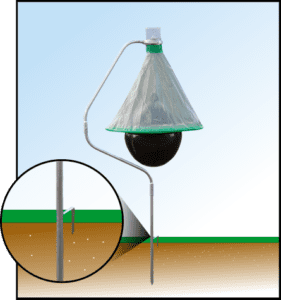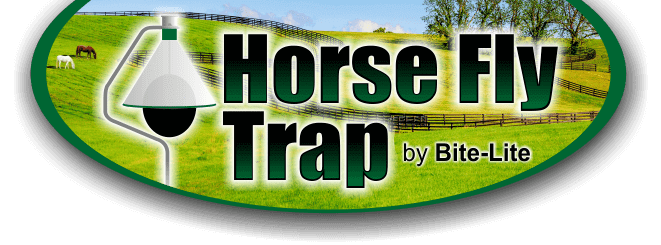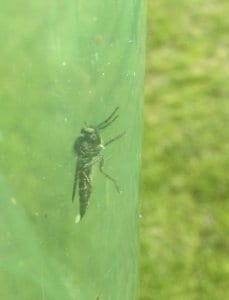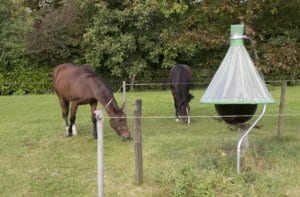What’s Nature Have to Do with Our Horse Fly Trap’s Success?
Nature goes hand in hand with the design and effectiveness of our professional horse fly control system and trap. Horse flies typically fly vertically, and it is this flight pattern that our horse fly trap exploits in catching the biting female horse fly and trapping it. Three elements attract female horse flies into finding the blood source that enables them to reproduce– contrast, heat sensory, and scent. By placing our horse fly traps in strategically sunny locations, ideally where horses and people congregate, the inflatable black ball will begin to do its job in tricking the horse flies to come on to it. When the inflatable black ball absorbs heat, it gives off an infrared signature which attracts the biting female horse fly to the ball rather than to the animals and humans nearby. Once on the black ball, the females will try to bite their “victims” but obviously without success. Because horse flies fly vertically, the green plastic conical hood guides them upwards into the green plastic collection bin that sits atop of the horse fly trap. From there, there is no escape and the horse fly will die from dehydration or drowning, if you added water to the collection bin.
What’s the Best Way to Optimize Your Horse Fly Catch?
 Location! Location! Location!
Location! Location! Location!
Once you have verified that you indeed have horse flies (tabanids) on your property or at your nearby neighbors, begin sleuthing to find the place that horse flies are likely breeding. If you can identify their breeding ground relative to where horses and humans congregate on your property, you can determine whether you want to trap horse flies where they are emerging as adults or closer to where you and your animals are located. If your property is over 2.5 acres and you have more than five horses needing protection from biting horse flies, you may want to consider setting up more than one trap and placing them in both locations. Knowing their flight patterns is key to your success in collapsing the horse fly populations on your property.
Generally, horse flies will lay their eggs on stones or vegetation close to a water body. From there the larvae will hatch and fall into nearby water or onto moist fecund soil, where they will feed on invertebrates such as snails, earthworms, and other insects. Adult horse flies can be seen emerging from damp areas such as ponds, riverbanks, swamps, fresh water and salt water marshes, moist forest soils, or soft decayed wood. Depending on the species of horse flies, a life cycle can take one to three years and consist of six to 13 stages of development. Horse flies live only a few days as adults, but have no trouble in that short time span flying hundreds of miles to find a mate (in flight) and locate a blood source for the reproductive cycle to begin all over again. One female horse fly can lay up to 100 to 800 eggs. Male horse flies feed on nectar and pollen; they don’t have the sharp mouth parts to bite and get blood like the female do.
If you are uncertain about which location would work best on your property, even prior to purchase, please give us a call and we will review your property on Google Maps to help.
When to Set Up Your Horse Fly Trap?
For best results in reducing a horse fly population, install your horse fly trap(s) just before the first adult horse flies emerge in your area, which is usually around late spring and early summer.
On the East Coast, adult female horse flies are first seen around April, and therefore you will want to be prepared and get your horse fly trap set up a few weeks before. In warmer climates, the adults emerge sooner and you should set your horse fly traps out earlier.
If you decide to place your horse fly trap close to where humans and animals congregate, we recommend you place it just outside a paddock or cattle yard where it would be protected by a fence. You don’t want a horse to brush up against the horse fly trap because this type of situation could spook your animal, injure the animal in the process, and also damage your trap. If you believe that inside a paddock or cattle yard is the best possible location for your horse fly trap, you will need to create a suitable barrier to keep your animals a proper distance away as is shown in the image here.
If you find that you are seeing horse flies, but are not catching enough of them, you need to move your horse fly trap to a new location. Often rethinking and repositioning your horse fly trap will reap the best results. The horse fly trap system is easily moveable.


